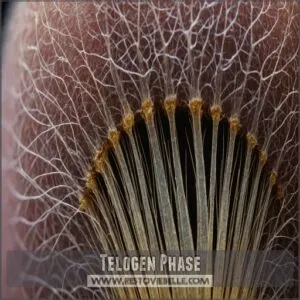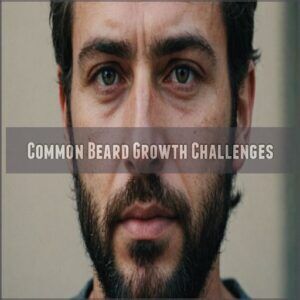This site is supported by our readers. We may earn a commission, at no cost to you, if you purchase through links.
 Growing a beard isn’t a sprint; it’s a marathon, taking anywhere from 2 to 6 months to reach full glory.
Growing a beard isn’t a sprint; it’s a marathon, taking anywhere from 2 to 6 months to reach full glory.
So, grab your patience—it’s influenced by factors like genetics, age, and even hormones.
While your buddy might sprout facial hair like a Chia Pet, yours could be a slow-blooming masterpiece.
On average, expect about half an inch per month, but don’t lose heart if it’s a bit patchy at first.
A consistent grooming routine can work wonders, giving your beard that edge.
Ready to start this hairy adventure? We’ve got tips to make sure your beard journey is a smooth ride.
Table Of Contents
- Key Takeaways
- Factors Affecting Beard Growth
- Beard Growth Cycle Phases
- Average Beard Growth Timeline
- Stages of Beard Growth
- Benefits of Growing a Beard
- Maximizing Beard Growth Potential
- Common Beard Growth Challenges
- How Long Does It Take to Grow a Beard
- How to Grow a Beard Faster
- Maintaining a Healthy Beard
- Frequently Asked Questions (FAQs)
- How long does a beard grow?
- How many inches does hair grow per year?
- How to grow a beard in a week?
- How much hair does a beard grow per week?
- How long does it take to grow a beard after shaving?
- How hard is it to grow a beard?
- How Long It Takes to Grow A Beard as A teenager?
- How long does it take for a beard to fill in?
- How quickly does a beard grow?
- How can I speed up my beard growth?
- How long does it take an average man to grow a beard?
- Does beard color affect growth speed?
- Can stress slow beard growth?
- How does diet impact beard growth?
- Will minoxidil help my beard grow?
- Whats the average beard length?
- Conclusion
Key Takeaways
- Growing a full beard typically takes 2 to 6 months, influenced by genetics, age, and lifestyle factors, so patience is key.
- Facial hair growth can be influenced by various factors, including genetics and facial hair patterns. On average, facial hair grows about half an inch per month; some people might see faster growth due to their unique genetic makeup.
- Using beard growth oil that nourishes hair follicles and promotes blood circulation, such as beard growth oil formula, can also support beard growth. Maintaining a balanced diet, regular exercise, and good skin care can help maximize your beard’s growth potential.
- Embrace the natural growth stages, and focus on a consistent grooming routine to manage itchiness and patchiness effectively.
Factors Affecting Beard Growth
You’ll be surprised to learn that your beard’s growth journey depends on much more than just waiting it out.
From your DNA to your daily habits, several key factors will shape how quickly and fully your facial hair transforms from stubble to a magnificent mane.
Genetics and Beard Growth
While your DNA blueprint largely determines your beard’s destiny, it’s not set in stone.
Your genes influence follicle size, hair density, and growth patterns – traits typically shared within families.
If your dad and grandpa sport thick beards, you’ve likely hit the genetic jackpot.
But even with less-than-ideal genes, proper care and patience can help you maximize your beard’s natural potential.
Age and Beard Development
Your beard’s growth journey kicks off during puberty, typically around age 13-15, when testosterone levels start rising.
Peak beard growth happens between ages 25-35, when you’ll notice thicker, fuller facial hair.
After 35, growth might slow down, but proper care can help maintain your beard’s health.
Don’t worry if you’re a late bloomer – everyone’s beard development timeline is unique.
Ethnic Differences in Facial Hair
Beard genetics play out differently across ethnic groups, like a global map of facial hair.
Caucasian men often grow thicker, fuller beards, while Asian men typically have lighter facial hair coverage due to fewer androgen receptors, which can be influenced by various asian beard growth hacks.
African and Middle Eastern men frequently develop coarser, curlier beard textures.
Native Americans might experience varying patterns of growth.
These differences shape unique styling approaches and cultural expressions of masculinity.
Hormonal Impact on Facial Hair
Just like race shapes your beard’s destiny, hormones play the starring role in facial hair growth.
Testosterone and its sidekick DHT are the power duo behind your beard’s thickness and growth rate.
Think of these hormones as your beard’s personal trainers – when they’re working overtime, you’ll notice faster, thicker growth.
But if they’re taking it easy, your beard might grow at a more relaxed pace.
And if you’re seeking a boost, you can always explore beard growth oils designed to promote healthy beard growth.
But if they’re taking it easy, your beard might grow at a more relaxed pace.
Medical Conditions Affecting Beard Growth
Several medical conditions can throw a wrench in your beard growth plans.
Understanding these underlying health issues helps you take control of your facial hair journey and find solutions that work.
- Hormonal imbalances and thyroid issues often lead to patchy or slow-growing beards
- Alopecia areata can cause sudden hair loss in circular patches
- Certain medications and skin conditions might interfere with follicle development
Beard Growth Cycle Phases
Just like the hair on your head, your beard follows a three-phase growth cycle that determines how quickly and thickly it’ll grow.
You’ll notice your facial hair growing at different speeds throughout these phases, which explains why some patches of your beard might look fuller than others at times.
Anagen Phase
The active growth phase of your beard, known as anagen, is where the magic happens.
During this phase, your hair follicles are working overtime, churning out new cells that’ll become your facial hair.
This powerhouse phase can last anywhere from 2-6 years, and that’s what determines your beard’s maximum potential length.
Think of it as your beard’s growth spurt – it’s unstoppable!
Catagen Phase
After the active growth phase, your beard enters a brief two-week rest period called the catagen phase.
During this time, your facial hair detaches from its follicle but stays in place.
Think of it as your beard taking a quick power nap – it’s not growing, but it’s getting ready for what’s next.
You won’t notice much change, but important things are happening beneath the surface.
Telogen Phase
During telogen phase, your beard takes a well-deserved break, lasting 2-4 months while hair follicles recharge. Think of it as your facial hair’s power nap – it’s not being lazy, just preparing for the next growth spurt.
Here’s what’s happening during this rest phase:
- Old hairs remain anchored while new ones prepare to emerge
- You’ll naturally shed 1-100 strands daily
- Each follicle operates independently, ensuring continuous growth
Average Beard Growth Timeline
You’ll notice your beard growing about half an inch each month, though some lucky guys can sprout a full inch in the same time.
The rate at which a beard grows varies among individuals, largely influenced by hormone levels and genetics. Full beard growth takes time.
If you’re planning to grow a full beard, you can expect to wait anywhere from two to four months before you’re sporting that impressive facial forest you’re dreaming of.
Daily Growth Rate
Understanding your beard growth cycle is heavily influenced by vitamin D for beard growth what vitamins help growth, which regulates testosterone levels, stimulating facial hair growth. Understanding your daily beard growth gives you the power to master your facial hair journey.
While every guy’s growth follows the hair cycle phases, you’ll see about 0.3-0.5mm of growth per day.
Here’s a breakdown of what to expect:
| Growth Type | Daily Rate (mm) | What It Means For You |
|---|---|---|
| Slow | 0.3 | Patient grooming needed |
| Average | 0.4 | Standard growth pace |
| Fast | 0.5 | More frequent trimming |
| Super Fast | 0.6 | Daily maintenance required |
| Exceptional | 0.7+ | Welcome to the beard club! |
Monthly Growth Rate
Your beard will typically grow about half an inch each month, giving you decent coverage to show off.
Think of it like a plant – some guys’ beards shoot up like bamboo while others grow more like a bonsai tree.
Your genetics, hormones, and lifestyle all play their part in this monthly race.
For most guys, you’ll see noticeable progress within 4-6 weeks.
Full Beard Development Period
While most guys dream of sporting a magnificent beard, the full development period typically spans 2-4 months.
Here’s what you can expect in your journey to peak beard glory:
- First month brings noticeable coverage and initial shape
- Second month fills in patches and establishes density
- Third month reveals your beard’s true potential
- Fourth month achieves full thickness and styling options
Individual Variation in Growth Speed
Everyone’s beard grows at its own unique pace, shaped by genetics and hormones.
You might notice your facial hair sprouting like a garden in spring, while your friend’s grows at a snail’s pace.
Factors like age, diet, and lifestyle habits play key roles too.
On average, a beard grows about a third to half an inch each month, depending on the beard growth cycle.
Some guys can rock a full beard in two months, while others might need six months for the same length.
Stages of Beard Growth
As you begin your beard-growing journey, you’ll navigate through various stages, each with its own quirks and surprises.
From the initial stubble to the full, glorious beard, understanding these phases will help you embrace the process and keep you from reaching for the razor too soon.
The Stubble Stage
During the first couple of weeks, you’ll notice the beginnings of your majestic beard—stubbly growth, maybe a little patchy, and it’s not uncommon for this phase to start around 15 or 16 years old, marking the initial facial hair growth timeline.
It’s the start of something great!
- Stubble length varies.
- Patchy growth is normal.
- Patience is key.
- Consider beard oil.
- Basic grooming tips help.
The Itchy Stage
After rocking the stubble stage, you’re moving into the "scratch-your-chin-and-sigh" phase.
The itch can feel like tiny rebels staging a coup on your face.
But fear not, relief is within reach!
You can try using a specialized balm for itch relief to soothe your skin.
Beard oil becomes your trusty ally, soothing skin and taming those wild whiskers.
Embrace this itchy chapter; it’s proof your beard’s gearing up for greatness!
The Unkempt Stage
You’re knee-deep in the unkempt stage, where patience and commitment are your best allies.
Your beard’s looking wild, perhaps a garden of uneven growth.
Fight the urge to trim too much; just neaten the edges.
Embrace the chaos, folks!
Your whiskers need time to find their groove.
Focus on good beard care and let time work its magic.
The Real Beard Stage
When you reach the Real Beard Stage, it’s like leveling up in your beard journey.
Embrace the fullness and style with purpose!
Focus on:
- Beard care routine: Keep it clean and nourished.
- Styling options: Experiment with different looks.
- Patchy growth: Camouflage with strategic grooming.
- Beard oils: Use for softness and shine.
Enjoy your commanding presence!
Benefits of Growing a Beard
Growing a beard isn’t just about looking ruggedly handsome; it also offers a host of health benefits, like protecting your skin from the sun and keeping it moisturized.
Plus, it reduces the need for shaving, which can help prevent acne and boost your confidence, sometimes even making you feel like a superhero in your daily routines!
Offers Protection From UV Rays
Sporting a beard isn’t just about style; it’s your shield against the sun.
Facial hair acts like natural sunscreen, keeping harmful UV rays at bay and reducing sunburn risks.
Imagine your beard as a tough, grizzled sentinel, always on duty for UV protection.
So, whether you’re basking in the sun or just out and about, your beard’s got your back.
Lessens The Need for Shaving That Causes Acne
Shielding your skin from UV rays is smart, but how about dodging that daily shave?
With a beard, you lessen the chances of shaving and acne breakouts.
Shaving can be rough on acne-prone skin, often causing irritation and razor burn.
A natural beard offers a break, sparing your skin the turmoil of daily blade battles.
Raises Your Confidence
Letting your beard grow isn’t just about avoiding razor burn; it’s a confidence booster.
A well-groomed beard can seriously upgrade your self-esteem and body image.
It’s a statement, a way to express your personal style and masculinity.
You’ll feel more put-together, maybe even a bit more powerful.
That extra swagger? It’s the beard effect.
Social acceptance often follows, too.
Embrace the beard, embrace yourself.
Prevents Gum Diseases
Imagine your beard as a loyal guardian, creating a bacteria barrier that helps keep your mouth healthy.
While boosting confidence, it also aids oral hygiene.
However, it’s important to remember that genetics and age play a significant role in beard growth patterns, with some men experiencing patchy growth due to hormonal fluctuations during puberty hormonal fluctuations during puberty.
How does this furry protector work its magic?
- Filters airborne germs.
- Shields gums from bad bacteria.
- Reduces skin irritation.
- Encourages better beard care routines.
Moisturizes The Skin
Picture your beard as a natural barrier against drying winds, keeping skin soft and irritation-free. Unlike those relentless razors, your beard hydrates and prevents shaving woes.
Try these tips:
| Tip | Description | Benefit |
|---|---|---|
| Beard Oil | Moisturizes and soothes | Reduces dry skin |
| Less Shaving | Fewer irritations | Combat skin redness |
| Beard Balm | Locks in moisture | Improves skin texture |
Who knew freedom could feel this smooth?
Maximizing Beard Growth Potential
You’re keen on turning that patchy scruff into a majestic beard masterpiece, and it’s all about optimizing your growth game.
With a diet plan that makes Popeye proud, some exercise, and a good night’s sleep, you’ll give those follicles the winning edge they need.
Nutritional Support for Facial Hair
You’ve embraced the benefits of a beard, now let’s talk food.
A diet for beard growth that complements tools like microneedling tools can help stimulate collagen production and enhance facial hair growth. A diet for beard growth is like rocket fuel for your facial hair.
Load up on protein-rich foods, chomp on veggies, and sip your vitamins.
It’s not magic, just healthy eating for beard health.
Avoid vitamin deficiency; treat your beard to the nutrients it craves!
Exercise and Beard Growth Correlation
Boost your beard game with regular exercise routines.
You see, working out elevates testosterone levels and increases blood flow to hair follicles, stimulating growth.
It’s like giving your beard a little gym session of its own.
So, hit the gym or take a brisk walk.
Anything that gets your heart pumping can help those growth hormones do their job.
Stress Management for Optimal Growth
After tackling exercise’s role in boosting beard growth, let’s chat about stress.
It sneaks up on you, affecting your beard’s potential.
Embrace stress-reducing activities that make a difference:
- Try a quick meditation session to clear your mind.
- Practice relaxation techniques like deep breathing.
- Explore mindfulness practices for inner peace.
- Enjoy activities that make you laugh!
Stay relaxed, grow strong!
Sleep Quality and Beard Development
Managing stress is a big step, but getting enough sleep is equally important for a thriving beard.
Think of sleep as your beard’s secret weapon.
Sleep deprivation slows down beard growth; your body needs those REM sleep cycles to repair and rebuild.
Aim for 7-9 hours of quality sleep each night to support healthy beard growth and overall beard health.
Consistent sleep cycles help you look and feel your best, a fuller beard included!
Grooming Practices for Encouraging Growth
Getting your beard to flourish needs more than just good sleep.
Try these:
- Use beard oils: They hydrate and soften those whiskers.
- Wash regularly with beard washes: Keeps the skin clean and follicles clear.
- Brush daily with a beard brush: Encourages growth and detangles pesky knots.
With these steps, your beard’s future looks bright!
Common Beard Growth Challenges
Growing a beard isn’t always smooth sailing; you might face challenges like patchy growth, slow hair rates, or itching that feels like a thousand tiny ants marching across your face.
But don’t worry, these hurdles are common and with a bit of patience and the right care, you can overcome them and sport a beard worthy of admiration.
Patchy Beard Growth
Sometimes, it feels like your beard has a mind of its own, growing in patches like a poorly tended garden.
Patchiness is often due to genetics, but don’t lose heart!
Revamp your beard care routine, try beard growth supplements to stimulate growth, or consider a beard transplant.
Here’s a quick peek:
| Factor | Impact | Solution |
|---|---|---|
| Genetics | Major | Beard transplant |
| Hormonal Imbalance | Moderate | Check hormones |
| Beard Care | Significant | Regular grooming |
Slow Growth Rates
Is your beard slower than a tortoise in a marathon? Don’t fret—hormonal imbalances or stress might be tapping the brakes.
Dietary deficiencies could also be starving your beard’s potential.
Remember, genetics play their sneaky role too.
Focus on boosting hair follicle health with a balanced diet and stress management, and watch your facial forest thrive!
Uneven Beard Density
Uneven beard density can be frustrating, like trying to paint a masterpiece with missing brushstrokes.
Those patchy spots might have you wondering if your beard has a mind of its own.
But fear not, with a bit of patience and diligent care—like using beard oil and maintaining a healthy lifestyle—you can encourage growth and fill in those gaps naturally.
Itching and Irritation During Growth
Feeling the itch can turn the dream of a glorious beard into a scratchy nightmare.
That irritation you’re facing? It’s your whiskers poking through the skin, ready to break free.
To avoid common issues like ingrown hairs and dry skin, try to soothe beard pain with a combination of proper grooming and beard care routines.
Tame that beast with beard oil, a magical elixir easing discomfort while moisturizing.
Deploy these itching solutions, like warm water rinses and proper grooming, for smoother sailing through beard-land.
How Long Does It Take to Grow a Beard
So, you’re wondering how long it takes to grow a magnificent beard?
It usually takes a few months to grow a full beard, but that timeframe can vary wildly depending on your genes and other factors, so be patient!
How Long to Grow a Short Beard
Growing a short beard takes about 5-10 days.
Trust the process as your whiskers change from stubble to stylish short options.
- Short Beard Styles: Experiment with different looks that suit your face.
- Beard Oil Benefits: Keep it soft and itch-free with a few drops.
- Short Beard Maintenance: Trim regularly for a neat look.
- Patchy Beard Solutions: Embrace the uniqueness with confidence.
How Long to Grow a Full Beard
You’ve made it past the short beard phase and now you’re gunning for a full, luscious beard.
Generally, it takes two to six months to grow a full beard, but this timeframe varies depending on your genetics and beard care routine.
Genetics play a significant role, with some people’s beards growing faster and thicker than others.
Average Time Frame for Beard Growth
Patience is your best companion in the beard-growing journey.
While the timeline varies due to genetics and lifestyle, most experience visible growth over several months.
Typically, the process unfolds like this:
- First Month: Initial stubble, some itching.
- Two to Four Months: Fuller appearance develops.
- Five to Six Months: Solid, consistent growth.
- Beyond Six Months: Maintained maturity.
How to Grow a Beard Faster
Growing a beard faster might seem like a mythical quest, but with the right habits, you’re on the fast track to a lumberjack look.
Wash your face and give it a good massage daily; it’s like sending your facial hair little love notes, urging them to sprout swiftly.
Commit to Letting Your Beard Grow Naturally
It takes genuine patience to really grow a beard.
Think of it like nurturing a plant: you need time, a bit of care, and belief in the process.
Skip the razor, trust the natural growth stages, and embrace a bit of scruff.
Before you know it, different beard styles will be at your fingertips, showcasing individuality and flair!
Wash Your Face Two Times a Day
Twice-daily face washing is a game-changer for beard growth.
A simple cleansing routine helps keep your pores clear, preventing those pesky ingrown hairs and acne.
Cleanliness benefits extend beyond just a clearer complexion; it creates the perfect environment for healthy beard growth.
Think of it as prepping the soil for a bountiful harvest!
This facial skincare step is quick, easy, and totally worth it for that awesome beard you’re growing.
Massage Face
Think of facial massage as a secret weapon for beard growth.
Gently massaging your skin boosts blood flow, tickling those hair follicles awake and encouraging your beard to grow faster.
It’s like giving your face a morning coffee—stimulating and rejuvenating!
Just a few minutes daily promotes skin health and smooths the path to a fuller beard.
Exfoliate
After giving your face a good massage, grab some exfoliating tools to scrub away dead skin cells and unblock those follicle openings.
Exfoliate for beard growth by following these tips:
- Use a gentle scrub once a week to keep skin fresh.
- Choose natural ingredients for a soothing experience.
- Avoid harsh scrubbing to prevent irritation.
- Enjoy smoother skin that encourages growth.
Maintaining a Healthy Beard
Taking care of your beard is like keeping a hedgehog calm—tame those prickly bits!
A consistent care routine, with regular trimming and shaping, keeps your beard looking sharp and healthy, making it the star of your facial features.
Proper Beard Care Routine
Boost your beard game by remembering this simple care plan: Regularly wash your beard with a good beard wash to keep it fresh.
Use beard oil to soften and a beard balm to tame those wild strands.
Don’t forget to comb and brush regularly for a sleek look.
Master this routine, and your beard will show its true potential!
Trimming and Shaping The Beard
A well-groomed beard is like a masterpiece—trimming and shaping it requires the right tools and techniques.
Use quality beard trimming tools for precision.
Explore various beard styles and shaping techniques to find your signature look.
Try beard fading for a polished finish.
Consistent maintenance keeps your beard looking its best, boosting your confidence and style game.
Frequently Asked Questions (FAQs)
How long does a beard grow?
Your beard typically takes about two to six months to reach full growth, depending on genetics, age, and lifestyle.
Patience is key, as you navigate through stages of patchiness and itching to achieve that full beard glory.
How many inches does hair grow per year?
Hair typically grows about six inches per year on average.
It can vary based on genetics, health, and lifestyle.
Think of it as a steady climb, with your hair scaling about half an inch monthly.
How to grow a beard in a week?
Ever notice how some beards seem to sprout overnight?
While a week isn’t enough for a full beard, focus on consistent care.
Moisturize, exfoliate, and eat protein-rich foods to boost growth and appearance quickly.
How much hair does a beard grow per week?
Beards typically grow about 1/8 to 1/4 inch per week.
While genetics and lifestyle play a role, patience is key.
Just imagine watching a slow-motion race where every little bit counts, but the journey’s worth it!
How long does it take to grow a beard after shaving?
Growing a beard after shaving is a bit like watching a pot boil—typically, it takes 2 to 6 months to see a full beard.
Patience is key as individual growth varies due to genetics and lifestyle.
How hard is it to grow a beard?
Genetics play a big role, but a healthy lifestyle helps. Patience is key; it’s a marathon, not a sprint. Don’t sweat the small stuff—enjoy the ride!
How Long It Takes to Grow A Beard as A teenager?
Teen beard growth trudges through time; expect patience.
Most teens find facial fuzz blossoms between two and four months, with genetics as the wild card.
Embrace the journey, endure the itch, and celebrate each scruffy success!
How long does it take for a beard to fill in?
Expect your beard to fill in over a span of 2 to 6 months.
Patience is key as genetics, age, and care routines greatly influence this timeline.
Embrace the journey—it’s a marathon, not a sprint.
How quickly does a beard grow?
Beard growth rates vary, but on average, expect about half an inch each month.
Some grow faster, up one inch monthly, thanks to genetics, diet, and lifestyle.
Your beard’s journey is uniquely yours, so embrace it!
How can I speed up my beard growth?
Growing a beard’s like watching a tree take root—give it sun and time!
Boost growth by eating right, exercising, and using beard oil.
Patience pairs well with each, helping you cultivate that lush lumberjack look.
How long does it take an average man to grow a beard?
In two to four months, you can sport a full beard, though it varies from person to person.
Beard hair grows approximately 3 to 5 millimeters per day due to influences from genetics. Typically, beard hair grows about half an inch per month.
So, patience and a solid care routine are key!
Does beard color affect growth speed?
No, beard color doesn’t impact how fast it grows.
Hair growth speed is more about genetics, hormones, and lifestyle.
So, focus on a healthy diet and good grooming habits to get that beard growing strong!
Can stress slow beard growth?
Yep, stress can really throw a wrench in your beard-growing plans. It’s like your body’s saying, "Whoa, hold the hair!" Prioritize relaxation; a chill you is a growing you.
How does diet impact beard growth?
Eating well is like fuel for your beard.
A diet rich in proteins, vitamins, and minerals (like vitamin A, B, C, E, zinc, and iron) boosts hair growth.
So, pack your meals with nutritious foods!
Will minoxidil help my beard grow?
Minoxidil can help boost beard growth by increasing blood flow to hair follicles, encouraging thicker growth over time.
Some folks see results in about six months, but it’s best to chat with a doctor first.
Whats the average beard length?
Growing a beard is like nurturing a wild garden: it takes time.
On average, a fully grown beard can reach lengths of 12 to 36 inches, depending on your genetic lottery and dedication to beard care.
Conclusion
Much like Odysseus’ epic voyage, your beard-growing journey involves patience and perseverance.
Understanding factors like genetics and hormones will help manage expectations on how long it takes for your beard to reach its full potential.
While some parts of the journey might be itchy or patchy, stick with your grooming routine and enjoy the many benefits that a beard can bring.
Just remember, the best things take time, and soon you’ll have your own facial hair masterpiece.




















